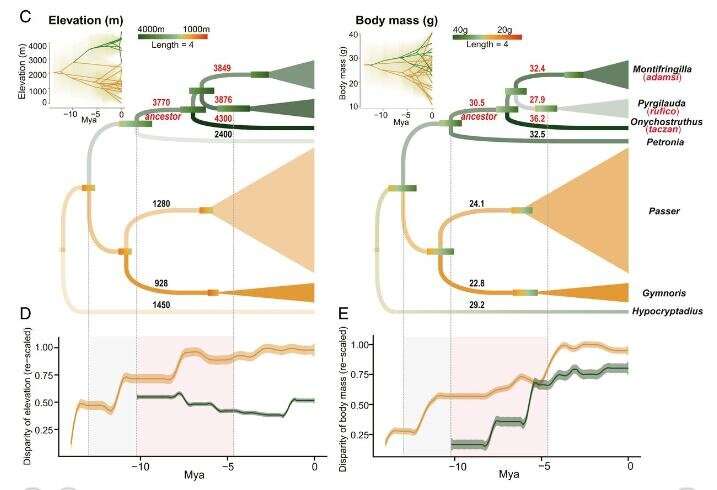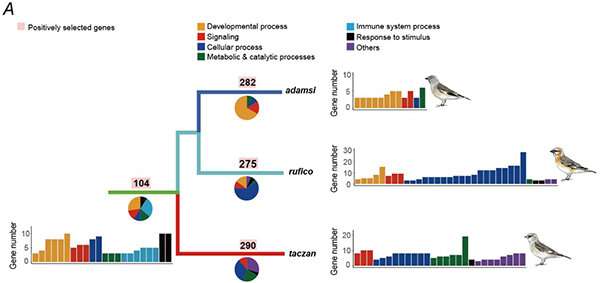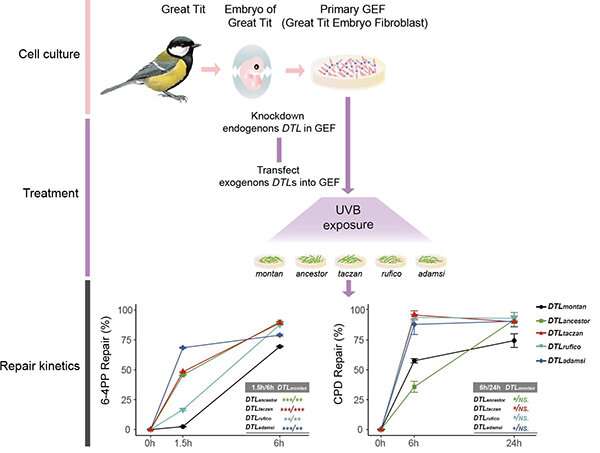Similar but not identical evolutionary trajectories of birds in adaptation to high-elevation environments

Ever since the era of Darwin, adaptive evolution has been a cornerstone of evolutionary biology. One essential related question is do animals adapt similarly to a shared environments? Indeed, scientists have long ago observed that animals usually evolve similar phenotypes in similar environments, and thus formulated classic ecogeographical rules, as e.g., "Bergmann's Law," "Allen's Law," and "Gloger's Law." These discoveries have led to a long-term hypothesis that adaptive evolution of phenotype to similar environments is convergent to a high degree.
However, contrary to the observations of convergence in phenotypic adaptations, genomic studies in the last twenty years have shown that genetic adaptations of animals living in similar environments often differ. Given that genetic adaptations rely heavily on the available inherited variation, it is therefore essential to address if species sharing a common ancestry evolve similar genetic adaptations.
In a recently published study, a research team led by Drs. Lei Fumin, Qu Yanhua, and Zhang Yonge from the Institute of Zoology (IOZ) of the Chinese Academy of Sciences, in collaboration with the Beijing Genomics Institute (BGI), have addressed this issue in an avian group, a snowfinch complex. This complex is one of very few avian groups that have diversified "in situ" in the high-elevation environments of the Qinghai-Tibet Plateau (QTP).
Using an integrated approach combining ancestral phenotypic reconstruction, comparative genomics and functional assays, the researchers described a novel case of adaptive evolution in which the descendants have evolved similar but not identical evolutionary trajectories to adapt to the extreme high-elevation conditions.

Unlike most other members of the avain family Passeridae, which are mainly distributed at low elevations, the snowfinches constitute an adaptive radiation to the high elevations in the QTP. Using the lowland relatives as the outgroup, the researchers reconstructed ancestral phentoypes and found that the ancestor of snowfinches was already adapted to high-elevation environments and also had a larger body mass than its closest relatives in the lowland.
The researchers then carried out comparative genomics and functional experiments using representatives of the three major clades of snowfinches. They demonstrated that the genetic background of the common ancestor only partly constrained the adaptive diversification of the three snowfinch species. That is, by searching the signals of positive selection, they found that only a dozen positively selected genes in the ancestor branch continued to be subjected to positive selection in the three descendants, but two of the three species (adamsi and rufico) are significantly similar to their ancestor in terms of biological functions of the positively selected genes.

A striking example of positively selected gene is a DNA repair gene, DTL. Although the DNA damage repair capacities was improved by amino acid changes in both the snowfinch ancestor and its descendants compared to lowland control bird (tree sparrows or montan), the repair kinetics differed across the ancestor and the three descandants.
Adaptation in different animals to the same environment is often achieved through similar phenotypic solutions. However, this study indicates that genetic adaptations follow more complex trajectories. That is, the common developmental and genetic architecture inherited from the ancestor together with microhabitats unique to each species shapes similar but not identical evolutionary trajectories.
More information: Yanhua Qu et al. The evolution of ancestral and species-specific adaptations in snowfinches at the Qinghai–Tibet Plateau, Proceedings of the National Academy of Sciences (2021). DOI: 10.1073/pnas.2012398118
Journal information: Proceedings of the National Academy of Sciences
Provided by Chinese Academy of Sciences




















